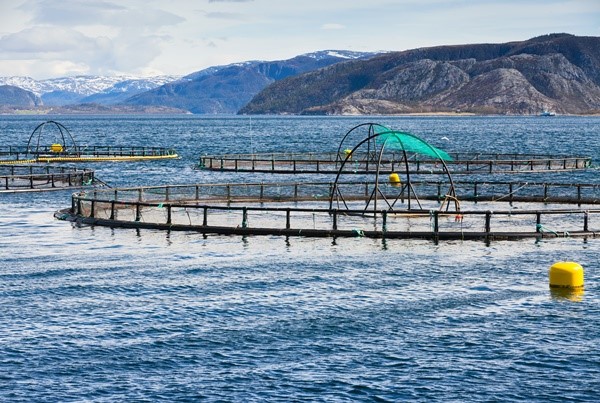
Lack of ability to control the threat of salmon lice may force salmon farmers to reduce production. © Shutterstock / Eugene Sergeev
Salmon Lice Forecast combines data from water forecast on temperature, salinity and currents and infection pressure with expert knowledge of the lifecycle and living conditions of salmon lice – to predict infection risk five days ahead. Armed with this information, farmers can now implement efficient treatments at the most optimal timings. This system is developed by DHI and Proactima in close collaboration with BluePlanet – a coordinating organisation of salmon farmers in one of the largest production areas in Norway.
What are salmon lice?
Salmon lice are tiny crustaceans that attach themselves to wild and farmed salmon and feed on them to survive, making the fishes unsuitable for sale, reduce market price and increase mortality. Secondly, increased numbers of salmon lice can have negative impact on wild salmon. This means loss of revenue for farmers and higher consumer prices for everything from salmon fillets to smoked salmon bagels.
These parasites have infested salmon farms in the US, Canada, Scotland, Norway and Chile. In Norway, salmon lice are costing the aquaculture industry more than half a billion USD every year. To avoid salmon lice limiting the stock of Norwegian wild salmon, authorities require documented proof of ability to control the occurrence of salmon lice on farmed fish before farmers can obtain green light to expand their production. Inability to control the threat of salmon lice may force salmon farmers to reduce production.
Scalable solution for worldwide salmon producers
The Salmon Lice Forecast has been implemented in Norwegian salmon farms to help farmers tackle the challenges of salmon lice. At the same time, the system is also playing a part in protecting wild salmon. This concept is scalable to other major salmon producers around the world.
The main strategies to control the number of lice in the aquaculture nets include: chemical or hot water treatment applied as a bath treatment, biological treatment with cleaner fish, and physical control like deepening the cages or setting up skirts around the farm.
Today, these treatments are applied with little consideration of infection risk or dispersal through transport with water currents. This is set to change with the introduction of the new solution.
‘We are excited by the level of accuracy we see from the system so far. It is truly rewarding being involved in this project, where the combination of domain expertise with user involvement and feedback into the design, has resulted in a system that can contribute to fight one of the most critical challenges facing both the farmed salmon industry as well as for the wild salmon stocks.’
- Odd Adler-Gjerde, Managing Director of DHI Norway
Clients’ reactions are positive, especially towards the forecast of high/low current periods, which is tremendously useful for treatment planning and operational optimisation in general. When the salmon farmer has knowledge of the infection risk several days ahead, he is able to optimise both the timing and type of treatment and make the decision to postpone treatments until just after a high-risk period. Using curtains around cages or deepening of the cages is also most efficient during high infection risk periods, which can be determined beforehand. With optimised planning, it is possible to reduce number of treatments, costs and environmental impact.
More information
Version 2.0 of the Salmon Lice Forecast is planned to be launched in the first quarter of 2019. Contact us for more information.